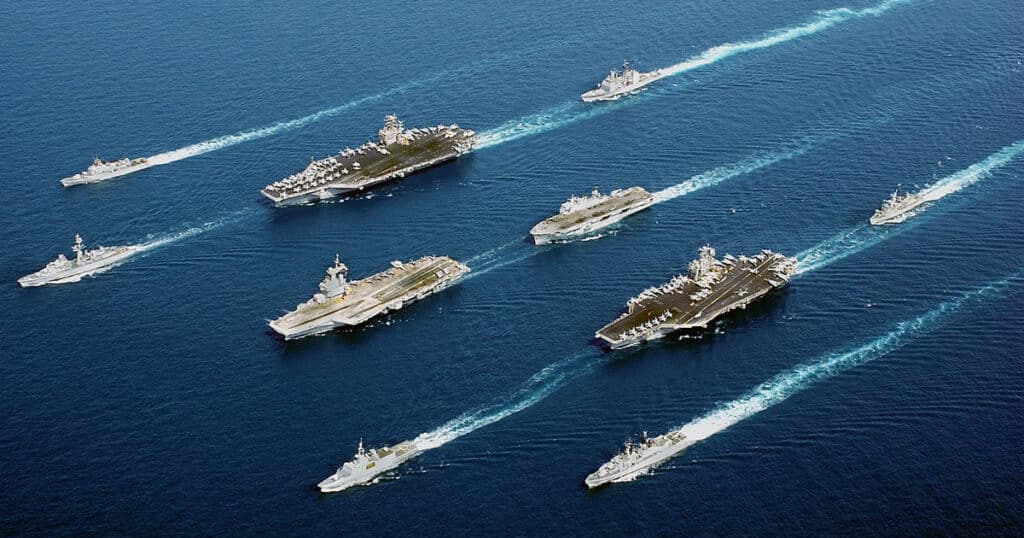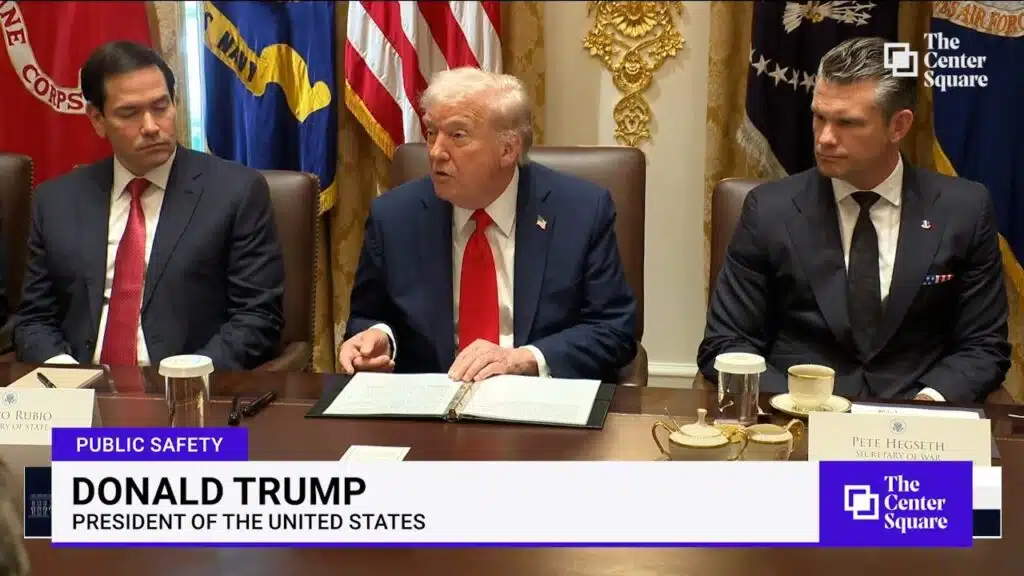
A Memo to Our Presidential Candidates—Restore Our Naval Dominance
MEMORANDUM FOR KAMALA HARRIS AND DONALD TRUMP
Subject: Restoring our Navy to Global Dominance
As both of you continue your campaigns to become President of the United States and assume your role as Commander-in-Chief, it’s hoped you and your national security advisors understand the importance of restoring our Navy to its preeminent posture. For the past 250 years, the U.S. Navy has ruled the seas and been the dominant maritime power in the world.
A nation’s standing in the world has always been judged by the strength of its naval fleet—both the quantity and quality of its ships and the people who man them. The importance of a strong navy had its roots with a book written in 1890 by Captain Alfred Thayer Mahan—”The Influence of Sea Power Upon History.” Mahan believed that national greatness was inextricably associated with the sea. Mahan argued that national prosperity and power depended on control of the world’s sea lanes.
“Whoever rules the waves rules the world,” said Mahan. He has been referred to as the intellectual father of the U.S. Navy and the “evangelist of sea power.”
President Theodore Roosevelt was clearly influenced by Mahan’s book when he sent the world a powerful message by building the Great White Fleet and sent 16 new battleships on a worldwide cruise in 1907. Roosevelt’s message was the U.S. was a maritime power with a capable and congressionally supported blue-water fleet.
“A good Navy is not a provocation to war. It is the surest guaranty of peace,” said Roosevelt.
Support for a strong maritime capability continued during the Woodrow Wilson administration when the fleet’s size was tripled. It was further strengthened when President Franklin Roosevelt and Rep. Carl Vinson expanded our Navy. At Vinson’s urging, Congress passed the Two-Ocean Navy Act in 1940. This was then the largest naval procurement legislation in U.S. history. It increased the size of the Navy by 70%, authorizing the construction of certain ships.
Vinson’s actions were extraordinarily prophetic as he felt our capabilities in both the Atlantic and Pacific should be increased, especially if the U.S. became involved in a global conflict that threated our nation. A year later Japan attacked Pearl Harbor. While World War II raged on for several years, the Two-Ocean Navy Act proved to be a key to our success in the war because many of the ships to see action were already being built.
However, while leaders like Roosevelt and Vinson saw the need and benefits from a strong maritime presence, we’ve seen the Navy shrink to levels that should cause alarm. Unfortunately, our military and political leaders have either forgotten the importance of Mahan’s work or have chosen to put his books on the shelf.
But while we have forgotten the work of Mahan, Chinese leaders have obviously studied his theories as China’s navy has been transformed into a modern and capable force. In its most recent report on the Chinese navy, the Congressional Research Service says China’s fleet has surpassed the U.S. Navy in numbers of battle force ships. It is now the largest navy in the world with a battle force of over 370 platforms. It’s expected to grow to 395 ships by 2025 and 435 ships by 2030.
The U.S. Navy, by comparison, has 296 battle force ships and is projected to have 294 in 2030.
As Presidential candidates, you should be concerned—perhaps alarmed—regarding the pace of China’s naval shipbuilding effort. More specifically, China’s shipbuilding industry compared with the capacity of the U.S. shipbuilding industry should get your attention. It’s estimated that China’s shipbuilding industrial base has a capacity 230 times that of ours.
Our industrial base, quite simply, is woefully inadequate and decrepit. Many of our shipyards have been shut down since the end of the Cold War. What this equates to is an inability to not just build new ships but to maintain and repair existing ones. All these factors contribute to a lack of U.S. Navy readiness.
In his essay “Alfred Thayer Mahan: Still Relevant in the 21st Century,” Frederico Bordonaro, a noted geopolitical scholar, says China’s naval strategy in the 21st century reflects a turn towards Mahanian principles, incorporating them into its strategic planning and decision-making process. This adaptation, Bordonaro says, is part of a broader shift in China’s approach to naval power—aiming to assert control over critical maritime areas and ensure safe passage of vital trade routes.
Bordonaro says as China embarked on economic reforms in the 1970s and early 1980s and began to see the importance of maritime trade, it started to recognize the strategic value of controlling sea lanes and establishing a strong naval presence. And so began the growth of the Chinese navy.
As a potential President, each of you should understand our nation’s security and prosperity depend on free and open international waters. In a $115 trillion global economy, 80% of trade by volume and 70% by value moves be sea. Additionally, 95% of international data moves along undersea cables.
Up until recently, access to the world’s oceans has fostered an era of stability and peace for nations. The U.S. and other fair-minded countries have long understood the importance of a rules-based international system that relied on a shared commitment to protecting this global approach. The U.S. Navy has been at the forefront of maintaining this peaceful posture and has helped provide that stability and ushered in prosperity for billions of people across the world.
But the international rules-based system is being challenged. China continues to grow its navy at an exponential rate. Similarly, Russia is clearly intent on reassuming the stature it held during the Cold War. Iran, through its proxies like the Houthis in Yemen, are disturbing shipping in the Red Sea. The Houthis have launched nearly 200 attacks since last November on both commercial and warships of friendly counties. Just recently, the Houthis attacked three U.S. Navy ships in the Red Sea using missiles and drones. Fortunately, all the weapons were either shot down or failed.
Our sailors have been doing a spectacular job operationally in the Red Sea area. None of our ships have been hit and all have been able to defend themselves, a testament to the quality of our sailors. However, we don’t have enough ships to continue this mission of protecting commercial commerce. Additionally, our men and women are stretched thin and taxed 24 hours a day.
An unfortunate accident illustrates the Navy’s current state.
Last month the one Navy oiler in the Middle East that refueled our ships operating in that region ran aground. The ship was part of the logistics fleet manned by civilians and overseen by the Military Sealift Command (MSC). The ship was forced to go into port for repairs, essentially leaving our warfighting ships without a fuel source and greatly diminishing our capabilities in that important region.
Sadly, MSC had recently announced that it was going to lay up 17 of its logistics ships because they could not man them. This leaves a troubling vacuum of support for our ships when they are deployed. It also makes statement about the condition and readiness of our Navy.
Adm. Lisa Franchetti, the Navy’s Chief of Naval Operations, recently released a plan that will help the Navy meet the challenge presented by China. The goal of her plan is to increase the Navy’s overall readiness and have 80% of the force ready at any given time to deploy for combat. Her plan includes a range of goals ranging from removing delays in ship maintenance to the development and use of drones and other autonomous systems.
As well thought out as Adm. Franchetti’s plan is, it will take buy-in and support from you, our future President, our Defense Department leadership and members of Congress. Most importantly, the American public needs to understand the importance of having a strong Navy and maritime presence. You need to make that case.
President John F. Kennedy, speaking to the crew of USS Kitty Hawk in 1962, echoed the words of Mahan when he said: “Control of the sea means security. Control of the seas can mean peace. Control of the seas can mean victory. The United States must control the seas if it is to protect our security and those countries which stretch thousands of miles away that look to you and this ship and the sister ships of the United States Navy.”
As you prepare for the possibility of becoming President, it would be beneficial for you and your national security teams to review and understand the importance of sea power that Alfred Thayer Mahan espoused. You must acknowledge and tell your constituencies that the world we live in is a dangerous one.
If we are to prosper as a country, we have no choice but to restore our Navy to its greatness and help shape the world to one that is peaceful and stable. Otherwise, China, Russia and Iran will do it for us.
Tom Jurkowsky served on active duty for 31 years, beginning his career as an enlisted sailor. He is the author of “The Secret Sauce for Organizational Success: Communications and Leadership on the Same Page.” He is a board member of the Military Officers Association of America. The opinions expressed are his own.
This article was originally published by RealClearDefense and made available via RealClearWire.


